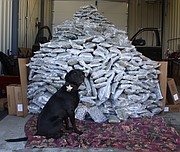The case for a K9: not so far fetched
The last time the Shoshone County Sheriff’s Office (SCSO) had a K9 was in 2004.
Since this time, the Sheriff’s Office and other local agencies in the Silver Valley have had to depend on outside help when a K9 has been needed.
Shoshone County Sheriff Mike Gunderson is hoping to change that.
In 2016 alone, there were several instances in Shoshone County where the many skills of a K9 and their handlers were employed to resolve a situation.
Many may recall that on May 23, 2016, former Pinehurst Doctor Rafael Beier was arrested for failing to appear for the reading of his verdict on May 17.
Beier was convicted in federal court on 66 counts of conspiracy to deliver controlled substances two weeks earlier.
On the day he was arrested, members of the North Idaho Violent Crimes Task Force and SCSO surrounded the RV he was hiding in on his property near Pinehurst.
The United States Attorney’s Office reported that Beier initially refused to surrender, but capitulated quickly after police threatened to send a K9 into the RV.
This situation is an example of a K9 being used as a deterrent to using deadly force and increasing officer safety.
On the drug detection front, the examples are numerous here the Silver Valley.
At the end of September 2016, Idaho State Police (ISP) conducted an “enforcement emphasis” in the Silver Valley.
ISP troopers from across the state descended upon Shoshone County and the I-90 corridor for the purpose of “criminal interdiction and traffic safety,” ISP Cpl. Kevin Kessler explained.
During the three day emphasis, the law enforcement collaborative made several drug related arrests for marijuana, methamphetamine, LSD, prescription medications, and mushrooms with the help of drug detection K9’s from both ISP and the Bonner County Sheriff’s Office.
More recently, ISP’s drug detection dog “Ace” made the cover of the Shoshone News-Press on Jan. 21, 2017, when he and his handler arrested two suspects for drug trafficking and seized 378 pounds of marijuana (valued around $1.3 million) after a traffic stop on I-90 near Kellogg.
The bust was made only after Ace gave a positive alert (indication that there are illegal substances present) for illegal drugs.
Sheriff Gunderson, who used to utilize the skills of a K9 when he was with SCSO in the 90’s, believes that bringing a dog back to the office is a top priority to reducing the drug crime in the county.
“We have a large of influx of narcotics violations in this community and I think it would be a great asset, not only as a public relations tool, but also as a tool to combat drugs in Shoshone County.”
In 1994 when Gunderson was a deputy for SCSO, he and the rest of the Shoshone County Drug Task Force seized $931,510 worth of marijuana plants that year alone (that’s $1,508,562.22 today, adjusted for inflation).
In addition to marijuana busts, the Task Force conducted other operations in 94’ that lead to the seizure of several other illegal drugs (and paraphernalia) including methamphetamine, cocaine, mushrooms, and prescription medications.
Many of these drug busts were the result of hard work from Gunderson’s drug dog, deputy Zipper.
Reported in the Nov. 23, 1994 edition of the Shoshone News-Press, Zipper, a Labrador retriever, was purchased by the Sheriff’s Office earlier that month for $3,500.
Former Shoshone County Sheriff Dan Schierman said that all of the money was raised entirely from contributions made by local businesses and civic organizations.
Zipper was trained to detect all three narcotic groups that includes marijuana, hashish, cocaine, and methamphetamine.
Cpl. Kessler attests to the successfulness and indispensability of a law enforcement agency having a K-9.
“They are such an invaluable tool,” Kessler explains, “Some departments think that it is (a K-9) a luxury until they realize what they can do, then they get that it’s a necessity.”
It would seem that there are many advantages to having a K9 for the guys and gals doing the arresting, but what about those who take the arrested criminals to court?
Shoshone County Prosecuting Attorney Keisha Oxendine said that having a K9 involved in a case she is prosecuting is a game changer.
“In every case I can think of where a K9 has alerted, we’ve gotten a conviction,” Oxendine said, “whether it be by them pleading guilty or them being convicted at trial.”
Oxendine explains that from a legal standpoint, a K9’s credibility makes it an invaluable tool that allows both her and law enforcement to do things that could not be done without them.
“The big benefit on our end is that if a trained K9 for law enforcement gets an alert on a vehicle, there is a well established case law that says a certified K9 alerting on a vehicle is probable cause to search the vehicle.”
In court, the K9’s handler testifies on behalf of it and will defend its nose if brought into question.
Defense attorneys can question a K9’s credibility during a trial, but Oxendine said that it is rare and the dog almost always proves it is capable.
Gunderson recounted a time with Zipper where the dog’s ability to locate illegal substances was called into question in a specific drug case.
To prove his capability, Gunderson hid a single marijuana seed in the courtroom and Zipper immediately sought it out after he was brought in.
Zipper’s ability was never questioned in court again.
In a county where drug and narcotic crimes were the fifth highest reported offenses in 2015, (arguably influencing the four above it; namely larceny, simple assault, burglary, and vandalism in descending order) having a tool that could sniff out these illegal substances would be incredibly useful for a law enforcement agency.
“As we work on these narcotics violations, we see that a lot of our other crimes are related to narcotics violations,” Gunderson said.
“If we can do a better job investigating those crimes and arresting those folks, those other crimes will reduce as well.”
If the Sheriff’s Office received a K9, it would be the tip of the spear for the new drug task force Gunderson’s plans on forming to present an organized front against drug crime in the area.
The path to getting one though requires a significant amount of time, effort, and of course, money.
According to the North American Police Work Dog Association (NAPWDA), there are six basic topics that need to be covered when attempting to add a K9 to a small department: Show a need within your community, research and document the effectiveness of a K9 unit, liability, expenses, training, and public relations.
Gunderson is confident that with the support of the community, SCSO will be able to address all of these topics and bring a drug detection K9 to the area for the first time in over a decade.





